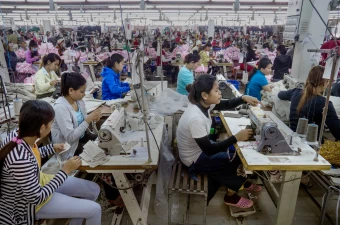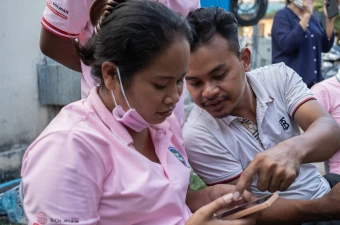How brands can help
On the 8th of October a multiparty dialogue was organized by the Vietnam Textile and Apparel Association (VITAS) and the Vietnam Leather, Footwear and Handbag Association (LEFASO) to discuss a sustainable recovery strategy for Vietnam’s garment and footwear industries after the COVID-19 pandemic.
Achieving a sustainable recovery requires a joint effort of manufacturers, buyers, business associations, trade unions, local government and agencies. However, it is important to acknowledge that in order to take care of worker well-being, Vietnamese businesses need the companionship and support of brands. Together we can transform the industry to become more resilient.
The context of COVID-19 in Vietnam
Vietnam remained relatively unfazed by earlier COVID-19 waves. However, the fourth wave – which started at the end of April 2021 - has shaken the country and its industries severely. With a relatively low vaccination rate - compared to other countries in the region infections have surged, thus paralyzing labor intensive production systems such as the garment and footwear industries.

This COVID wave has particularly hit the southern part of the country due to lock-down regulations. Luckily, infections have been decreasing since September. The country is now shifting from a lockdown situation towards a focus on a slow reopening of the economy and developing policies for living safely with the virus.
Main challenges
Because of this, new economic challenges have emerged. A September 2021 survey from VITAS and LEFASO conducted in over twenty provinces has revealed a number of key issues.
- Increased financial pressure on Vietnamese enterprises.
With clothing sales dropping due to the pandemic, nearly 20% of Vietnamese enterprises faced cancellation of orders from brands. Also, preventative measures, such as the 3-on-site model, that were undertaken at production sites severely increased operating costs, with an average of VND 2.2 billion (± EUR 83.000) per week for a factory with 1,000 employees.
Additionally, delayed deliveries resulted in brands penalizing factories as 68% of enterprises participating in the survey experienced penalties for late delivery of finished products. Factories often had to pay for shipment by air.
- Workers are in heavy weather.
Due to these circumstances, 62% of garment employees in Vietnam have (been forced to) quit working and lost their source of income. Moreover, the survey shows that 60% of workers who did maintain their job still experienced a reduction in their income. At the same time, social support policies are limited.
Additionally, 77% of (former) workers has been experiencing a negative impact on their mental health. The economic, health and mental exhaustion during the lockdown has made over 60% of migrant workers plan to return to their home villages. However, such a return to their home villages is not meant to be permanent: 89% of migrant workers and 96% of local ones wish to continue working at their present factories.
- Opening up the economy safely.
With infections decreasing, the Vietnamese government is developing dual policy goals to protect both lives and livelihoods. However, considerable barriers include the slow reopening of factories, the absence of migrants workers, and restrictions on travel of goods and workers.
for the daily lives of workers,
CNV Internationaal argues for different solutions.
Opportunities and solutions
Achieving a sustainable recovery requires a joint effort of manufacturers, buyers, business associations, trade unions, local government and agencies. However, it is important to acknowledge that in order to take care of worker well-being, Vietnamese businesses need the companionship and support of brands.
Consequently, there are four main recommendations for brands on how they can directly contribute to these goals and respect their due diligence:
- Compensate workers for inconveniences.
As “3-on-site” models are very disruptive for the daily lives of workers, CNV Internationaal is critical of this model and argues for different solutions. However, in cases where the factories are required to follow a "3-on-site" production model (meaning that workers need to work, eat and sleep inside the factories), brands should pay workers an allowance for their inconvenience, such as missing privacy for showers, toilets, and free leisure time.
- Pay for orders.
In all cases, whether production is continuing or has been paused, brands sourcing from Vietnam should pay in-full for the placed orders, as this is crucial for the factories to be able to pay the wages of their workers.
- Share costs.
Brands should contribute when extra costs are made for air shipments or COVID-19 testing fees.
- Debt relief and advance payments for Vietnamese suppliers.
Suppliers should receive advance payments so that wages for workers can be paid in a timely manner.

All in all, the Impact of COVID-19 on both garment and footwear factories and workers in Vietnam has been severe.
Through active involvement of industry stakeholders - including the brands - cooperation, and social dialogue, the industry can recover.
It can even become more resilient than before, which ultimately benefits all stakeholders
Publication date 21 10 2021


